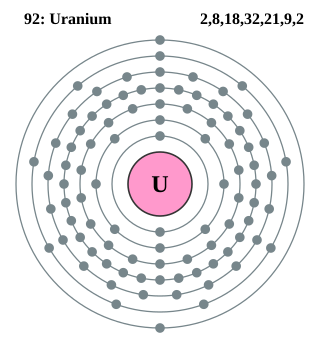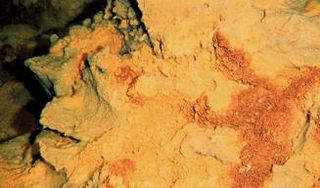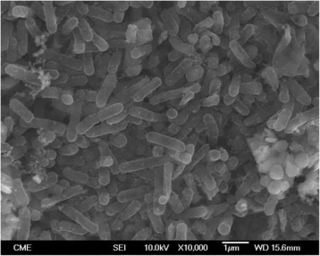
Acidithiobacillus is a genus of the Acidithiobacillia in the "Pseudomonadota". The genus includes acidophilic organisms capable of iron and/or sulfur oxidation. Like all "Pseudomonadota", Acidithiobacillus spp. are Gram-negative. They are also important generators of acid mine drainage, which is a major environmental problem around the world in mining.
Sulfur-reducing bacteria are microorganisms able to reduce elemental sulfur (S0) to hydrogen sulfide (H2S). These microbes use inorganic sulfur compounds as electron acceptors to sustain several activities such as respiration, conserving energy and growth, in absence of oxygen. The final product or these processes, sulfide, has a considerable influence on the chemistry of the environment and, in addition, is used as electron donor for a large variety of microbial metabolisms. Several types of bacteria and many non-methanogenic archaea can reduce sulfur. Microbial sulfur reduction was already shown in early studies, which highlighted the first proof of S0 reduction in a vibrioid bacterium from mud, with sulfur as electron acceptor and H
2 as electron donor. The first pure cultured species of sulfur-reducing bacteria, Desulfuromonas acetoxidans, was discovered in 1976 and described by Pfennig Norbert and Biebel Hanno as an anaerobic sulfur-reducing and acetate-oxidizing bacterium, not able to reduce sulfate. Only few taxa are true sulfur-reducing bacteria, using sulfur reduction as the only or main catabolic reaction. Normally, they couple this reaction with the oxidation of acetate, succinate or other organic compounds. In general, sulfate-reducing bacteria are able to use both sulfate and elemental sulfur as electron acceptors. Thanks to its abundancy and thermodynamic stability, sulfate is the most studied electron acceptor for anaerobic respiration that involves sulfur compounds. Elemental sulfur, however, is very abundant and important, especially in deep-sea hydrothermal vents, hot springs and other extreme environments, making its isolation more difficult. Some bacteria – such as Proteus, Campylobacter, Pseudomonas and Salmonella – have the ability to reduce sulfur, but can also use oxygen and other terminal electron acceptors.

Biomining is the technique of extracting metals from ores and other solid materials typically using prokaryotes, fungi or plants. These organisms secrete different organic compounds that chelate metals from the environment and bring it back to the cell where they are typically used to coordinate electrons. It was discovered in the mid 1900s that microorganisms use metals in the cell. Some microbes can use stable metals such as iron, copper, zinc, and gold as well as unstable atoms such as uranium and thorium. Large chemostats of microbes can be grown to leach metals from their media. These vats of culture can then be transformed into many marketable metal compounds. Biomining is an environmentally friendly technique compared to typical mining. Mining releases many pollutants while the only chemicals released from biomining is any metabolites or gasses that the bacteria secrete. The same concept can be used for bioremediation models. Bacteria can be inoculated into environments contaminated with metals, oils, or other toxic compounds. The bacteria can clean the environment by absorbing these toxic compounds to create energy in the cell. Bacteria can mine for metals, clean oil spills, purify gold, and use radioactive elements for energy.
Alicyclobacillus is a genus of Gram-variable, rod-shaped, spore-forming bacteria. The bacteria are able to grow in acidic conditions, while the spores are able to survive typical pasteurization procedures.

The class Zetaproteobacteria is the sixth and most recently described class of the Pseudomonadota. Zetaproteobacteria can also refer to the group of organisms assigned to this class. The Zetaproteobacteria were originally represented by a single described species, Mariprofundus ferrooxydans, which is an iron-oxidizing neutrophilic chemolithoautotroph originally isolated from Kamaʻehuakanaloa Seamount in 1996 (post-eruption). Molecular cloning techniques focusing on the small subunit ribosomal RNA gene have also been used to identify a more diverse majority of the Zetaproteobacteria that have as yet been unculturable.

Mariprofundus ferrooxydans is a neutrophilic, chemolithotrophic, Gram-negative bacterium which can grow by oxidising ferrous to ferric iron. It is one of the few members of the class Zetaproteobacteria in the phylum Pseudomonadota. It is typically found in iron-rich deep sea environments, particularly at hydrothermal vents. M. ferrooxydans characteristically produces stalks of solid iron oxyhydroxides that form into iron mats. Genes that have been proposed to catalyze Fe(II) oxidation in M. ferrooxydans are similar to those involved in known metal redox pathways, and thus it serves as a good candidate for a model iron oxidizing organism.
Sulfolobus metallicus is a coccoid shaped thermophilic archaeon. It is a strict chemolithoautotroph gaining energy by oxidation of sulphur and sulphidic ores into sulfuric acid. Its type strain is Kra 23. It has many uses that take advantage of its ability to grow on metal media under acidic and hot environments.

Acidithiobacillus thiooxidans, formerly known as Thiobacillus thiooxidans until its reclassification into the newly designated genus Acidithiobacillus of the Acidithiobacillia subclass of Pseudomonadota, is a Gram-negative, rod-shaped bacterium that uses sulfur as its primary energy source. It is mesophilic, with a temperature optimum of 28 °C. This bacterium is commonly found in soil, sewer pipes, and cave biofilms called snottites. A. thiooxidans is used in the mining technique known as bioleaching, where metals are extracted from their ores through the action of microbes.
Alicyclobacillus aeris is a species of Gram positive/Gram variable, strictly aerobic, bacterium. The bacteria are acidophilic and produced endospores. It was first isolated from a copper mine in Inner Mongolia, China. The species was first described in 2009, and the name is derived from the Latin aeris.
Alicyclobacillus contaminans is a species of Gram positive, strictly aerobic, bacterium. The bacteria are acidophilic and produce endospores. It was first isolated during a survey from both orange juice, and soil in Fuji City, Japan. The species was first described in 2007, and the name is derived from the Latin contaminans (contaminating).
Alicyclobacillus fastidiosus is a species of Gram positive, strictly aerobic, bacterium. The bacteria are acidophilic and produce endospores. It was first isolated from apple juice. The species was first described in 2007, and the name refers to the fastidious nature of the organism; the bacteria would start to die off after 7 days when plated on typical agar for isolating Alicyclobacillus. Additionally, the species produced fewer spores than other members of its genus, and took much longer to produce the spores.
Alicyclobacillus kakegawensis is a species of Gram positive, strictly aerobic, bacterium. The bacteria are acidophilic and produce endospores. It was first isolated from soil in Kakegawa, Japan. The species was first described in 2007, and the named after the city from which it was first isolated.
Alicyclobacillus macrosporangiidus is a species of Gram positive, strictly aerobic, bacterium. The bacteria are acidophilic and produce endospores. It was first isolated from soil in a crop field in Fujieda, Japan. The species was first described in 2007, and the name is derived from the Latin macros (big) and sporangium (sporangia), referring to the large spores produced by the organism.
Alicyclobacillus sacchari is a species of Gram positive, strictly aerobic, bacterium. The bacteria are acidophilic and produce endospores. It was first isolated from liquid sugar. The species was first described in 2007, and the name is derived from the Latin sacchari.
Alicyclobacillus shizuokensis is a species of Gram positive, strictly aerobic, bacterium. The bacteria are acidophilic and produce endospores. It was first isolated from soil in a crop field in Shizuoka, Japan. The species was first described in 2007, and the name refers to the city from which it was first isolated.
Alicyclobacillus cycloheptanicus is a species of Gram positive, strictly aerobic, bacterium. The bacteria are acidophilic and produce endospores. It was first isolated from soil. The species was originally classified as Bacillus cycloheptanicus in 1987, but further 16S rRNA studies found that the species belonged in the newly created genus Alicyclobacillus. The species name refers ω-cycloheptane fatty acids in the cell membrane.
Alicyclobacillus acidocaldarius is a species of Gram positive, strictly aerobic, bacterium. The bacteria are acidophilic, thermophilic, and produce endospores. The first identified strains of A. acidocaldarius were from geysers in Yellowstone National Park and fumerole soil in Hawaii Volcano National Park. The species was originally classified as Bacillus acidocaldarius in 1971, but further 16S rRNA studies found that the species belonged in the newly created genus Alicyclobacillus. The species name is derived from the Latin acidum (acid) and caldarius, referring to the acidic and high temperature environments from which it was first isolated. Thomas D. Brock was one of the researchers who first categorized the species; his discovery of Thermus aquaticus allowed for other researchers to discover Taq polymerase and polyermase chain reaction (PCR).
Alicyclobacillus disulfidooxidans a species of Gram positive, strictly aerobic, bacterium. The bacteria are acidophilic and produced endospores. It was first isolated from waterwater sludge in Blake Lake City, Quebec, Canada. The species was first identified in 1996, but was classified as Sulfobacillus disulfidooxidansis. It was reclassified as Alicyclobacillus in 2005. The name is derived from the Latin duplus (double), sulfur (sulfur), and oxido (oxidize), referring to the bacterium's ability to oxidize disulfide.
Alicyclobacillus tolerans is a species of Gram positive, strictly aerobic, bacterium. The bacteria are acidophilic and produced endospores. It was first isolated from oxidizable lead–zinc ores in Uzbekistan. The strain was first identified in 1983, but was classified as Sulfobacillus thermosulfidooxidans subsp. thermotolerans strain K1. It was reclassified as Alicyclobacillus in 2005. The species name refers to the ability to tolerate changes in temperature and pH.
Alicyclobacillus hesperidum is a species of Gram positive, strictly aerobic, bacterium. The bacteria are acidophilic and produced endospores. It was first isolated from solfataric soils in the Furnas, the Azores. The species was first described in 2000, and the name refers to the Hesperides, "mythological figures whom the Greeks believed to have lived at the Western edge of the Earth in a miraculous garden, which [the researchers] interpret as the Azores."




